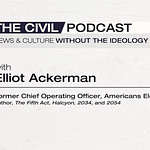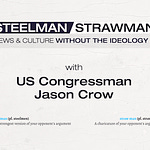My friend Aaron – the SEAL half of this equation – and I rerecorded this podcast more times than I care to admit. Part of the problem is that we spent most of our professional lives doing things you weren’t ever supposed to talk about. The other part is that we both feel the need to qualify or preface every statement, resulting in ten minutes of digression for every minute of forward movement: So, Ian, what was your experience like after 9/11? Well, to understand, start with the Lost Tribes of Israel and Alexander the Great marching through Afghanistan… no, wait… when the Arab armies invaded in the 7th century and the writings of Rumi and Ferdowsi (did you know that Pashto was the fourth language spoken in space?)… hold on… Marco Polo and the Afghan-Anglo wars of the 19th century… actually, start with the Soviet invasion of 1979… the CIA and the Mujahadeen and Rambo III… never mind, start over.
So, starting over: The goal of the Steelman/Strawman podcast is to understand our current perilous moment in America through the personal experiences of those living it; whether politics, media, or national security. I mean, yes, we are all living this moment, but our goal is to explore key events in the last 20 years with those who were there. In the first episode, we talked with General Stanley McChrystal about his time leading the Joint Special Operations Command. In the second, we met with Representative Jason Crow to talk about January 6th from his perspective on the House floor. In the current episode, Aaron and I talk about the first time – 20 years ago – that we remember the US Congress holding hearings on the disinformation in the American media. I’ll come back to that. But first, a digression.
Between Aaron, myself, and our close friends with whom we served, we were personally involved in, or had intimate knowledge of, some of the biggest national security stories from 9/11 to today; from Jawbreaker to Osama bin Laden, Afghanistan to Africa. I recall often seeing one of these stories in the news and thinking, “What thoughtful, thorough reporting.” Also, I remember often thinking, “What bullshit.”
This is not a revelation: sometimes the media gets it wrong. Sometimes we all do. Truth is hard and the world is complicated. Also, national security and war reporting are something of a last refuge for journalists not captured by the ideologies that so challenge domestic reportage. Further, this is not about the merely embarrassing mistakes, nor the media coverage around WMDs in Iraq; that’s an entirely separate category. My interest is in the process by which a single event goes from zero to complete congressional-investigation-into-disinformation-level bullshit, as with the Jessica Lynch rescue.
The story begins on March 23, 2003, three days into the Iraq war. The 507th Maintenance Company had been last in a 600-vehicle convoy advancing rapidly to Baghdad. After becoming separated, elements of the 507th took a wrong turn in Nasiriyah and were ambushed. Eleven soldiers were killed and seven were taken prisoner. Two of the prisoners were Private First Class Lori Piestewa and Private First Class Jessica Lynch, both badly injured. PFC Piestewa succumbed to her injuries after capture, becoming the first Native American woman to die in combat while serving with the US Army. PFC Lynch was too critical to be moved and was left in a hospital in Nasiriyah. The remaining prisoners, including Shoshana Johnson – the first black female prisoner of war – were taken to Samarra, 300 miles north of Nasiriyah. They were rescued by US Marines on April 13, 22 days after the ambush.
PFC Lynch became the focus of the story for arguably two main reasons. First, the US military knew the other prisoners had been moved, but they did not have the actionable intelligence needed to make a rescue possible. However, PFC Lynch – still in Nasiriyah – was closer to the forward line of battle, and US forces received intelligence that enabled her rescue soon after. Second – and key to our purposes here – initial reports radically misstated the circumstances of her capture. According to a Pew Research study of the press coverage:
The day after the rescue, April 2, the Associated Press quoted "officials who spoke on the condition of anonymity" who said Lynch had "at least one gunshot wound." That same day the New York Times cited "an Army official" as saying that Lynch "had been shot multiple times." On April 3, a front-page story in the Washington Post cited unnamed US officials and said that Lynch "fought fiercely" and that she sustained gunshot and stab wounds. "She was fighting to the death," the official was quoted as saying in the story. "She did not want to be taken alive." [i]
For the Bush Administration, it was the story of a lone female soldier fighting to the death in defense of her cause and country. For the media, it was the drama of a lone woman surrounded by men in direct ground combat. This powerful combination – where both the government and media want the same truth – turbocharged the initial, erroneous, reports from the field that PFC Lynch had fought ferociously.
But in fact, PFC Lynch did not have any gunshot or stab wounds; her injuries were sustained when her vehicle crashed, and she had not fired a shot. To her credit, PFC Lynch took great effort to correct the story. She was deeply disturbed that it was she – and not, as she later said, Lori, who had been the one fighting – who received such attention. And in the following weeks, the pendulum swung wildly from a heroic story about a lone soldier and her daring rescue, to accusations that it was all staged propaganda to flag morale and sell the war. The Guardian, for example, went with the enormously condescending and vaguely lurid title, “The Truth about Jessica;” often referring to her as “Private Jessica.” (The Guardian also gave us “Scars show Iraqi captors raped Jessica Lynch.”) USA Today ran the story, “Expert questions Silver Stars for SEALs in Lynch rescue” (an expert?). And soon, there was widespread doubt about the entire operation.
But the reporting about her capture and the truth of her rescue are two separate pieces. And for Aaron – who was a SEAL serving with JSOC in Iraq at the time – and every other American in Iraq, all that mattered was getting the POWs back. Aaron discusses the details of the rescue in the podcast, but a few things are worth highlighting: First, the size of the capture force – 400 Americans were involved – was cited by some in the media as proof that the entire operation was staged (how this is proof is not clear). But as Aaron explains, the city of Nasiriyah was not under American control and so getting in and holding the hospital where PFC Lynch was being held would require a large American force. Second, it is true that the Fedayeen had retreated from the hospital before the rescue force arrived, but Aaron and his team did not know that going in. And third, the previous operations executed by Aaron’s team to that point had been highly kinetic and all their helicopters had taken bullet strikes. There was no reason to think that this one would be different; especially given that they had reliable intelligence the hospital was being used as a Fedayeen (Iraqi paramilitary) base of operations.
The point is: what the rescue force believed they would be facing, and the complexity of the operation, are entirely separate from the narrative about PFC Lynch’s capture. And when it became clear that the media (and the Bush Administration) had been so wrong about one part of the story, doubt surfaced about all the rest. And Aaron would later find himself swearing under oath to congress that the operation was not staged. For the SEALs, soldiers, Marines, and airmen who went into what they believed was an operation where the entry team may be outnumbered ten to one, this was profoundly insulting. It was the story of the rescue and how this happened that Aaron and I discuss.
Note: We digress for a bit at the beginning. If you want to jump straight to Aaron’s story about the rescue, go to: 21:15
[i] Though new to me at the time, the cause here is old, described by Matt Taibbi as four-sourced-clovers.


















War, the media, and the Jessica Lynch rescue in Iraq 20 years on